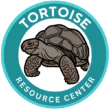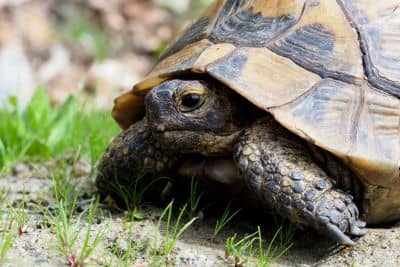If you’ve recently welcomed a baby sulcata tortoise into your home, you’re probably feeling overwhelmed by the responsibility of supporting healthy development during these critical first months. The decisions you make now will literally shape your tortoise’s shell, bone structure, and overall health for the next 50+ years—and there’s no second chance to get this right!
That’s the pressure I felt when I got my first sulcata tortoise. At the same time, I also had a baby horse, which posed the same pressure. They need to eat a lot and grow, but if they grow too fast, they can face serious problems. Talk about mom stress! That’s why I worked with scientists to develop the best tortoise nutrition products available including our Superfood Powder and Vitamin Supplement.
The challenge with sulcata growth is that it’s hard to tell how fast they are growing. And most care guides focus on preventing problems rather than actively promoting optimal development. They tell you what not to do but don’t give you the specific, actionable strategies needed to support the best possible growth outcomes for your individual tortoise.
Here’s the reality: to support baby sulcata growth requires a comprehensive, proactive approach that goes far beyond simply providing the best food, vitamins, minerals and heat. You need to understand how environmental factors, nutrition timing, exercise opportunities, and even stress management work together to create the foundation for lifelong health.
This guide will show you exactly how to create an environment that actively promotes healthy development, from the specific temperature and humidity combinations that optimize growth to the feeding strategies that build strong shells without causing deformities.
Understanding What Baby Sulcatas Need to Thrive
Baby sulcatas aren’t just smaller versions of adult tortoises—they’re developing organisms with dramatically different requirements for optimal growth. During their first 18 months, they’re simultaneously building bone structure, hardening their shells, developing organ systems, and establishing the digestive bacteria colonies they’ll need for life.
This complex development process requires precise environmental conditions, carefully balanced nutrition, and opportunities for natural behaviors that promote healthy growth. Miss any of these elements, and you risk stunted development, shell deformities, or long-term health problems that can’t be corrected later.
The key insight is that optimal growth isn’t about maximizing size or speed—it’s about supporting steady, sustainable development that builds a strong foundation for adult health. This requires understanding how different factors work together to either promote or hinder healthy development.
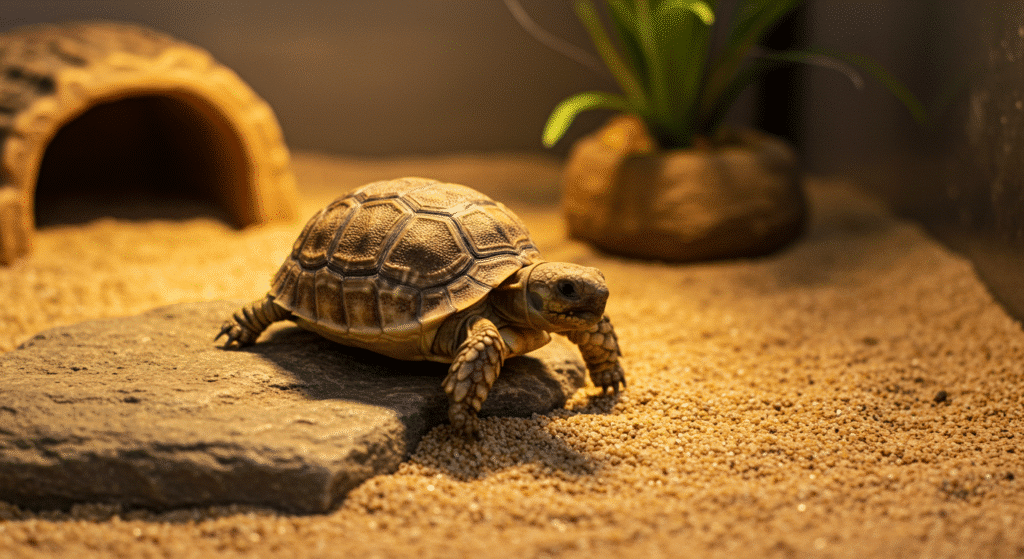
Creating the Optimal Growth Environment
Temperature Precision for Maximum Development: Baby sulcatas need very specific temperature ranges to support optimal growth. The basking area should maintain 95-100°F consistently, with a thermal gradient dropping to 75-80°F at the cool end.
But here’s what most guides miss: the transition between these temperatures should be gradual, not abrupt. Sharp temperature changes can stress developing tortoises and disrupt normal growth patterns. Create multiple intermediate temperature zones using strategic heat lamp placement and enclosure design.
Nighttime Temperature Management: Allow nighttime temperatures to drop to 70-75°F. This natural cooling period is crucial for healthy development and mimics the temperature fluctuations baby sulcatas would experience in the wild.
Humidity for Healthy Shell Development: Maintain 60-80% humidity during active periods, dropping to 40-50% at night. This humidity cycling supports proper shell development and prevents the dry conditions that contribute to pyramiding.
Use multiple humidity sources: large water dishes, substrate misting, and humid hide areas. Monitor humidity at tortoise level, not at the top of the enclosure where readings can be misleadingly high.
Lighting That Promotes Growth: Provide 12-14 hours of high-quality UVB lighting daily using 10.0 or 12% UVB bulbs positioned 12-18 inches from the basking area. UVB is essential for calcium absorption and healthy bone development.
Replace UVB bulbs every 6 months regardless of whether they still produce visible light—UVB output decreases significantly over time even when bulbs appear to be working normally.
Nutritional Strategies for Optimal Development
Growth-Supporting Base Diet: Focus on foods that provide steady nutrition without causing rapid growth spurts:
- 50-60% appropriate grasses (timothy, bermuda, orchard grass)
- 30-35% calcium-rich dark leafy greens (collard, mustard, turnip greens)
- 10-15% appropriate vegetables (squash, sweet potato, bell peppers)
- 5% maximum occasional treats (prickly pear, hibiscus, safe fruits)
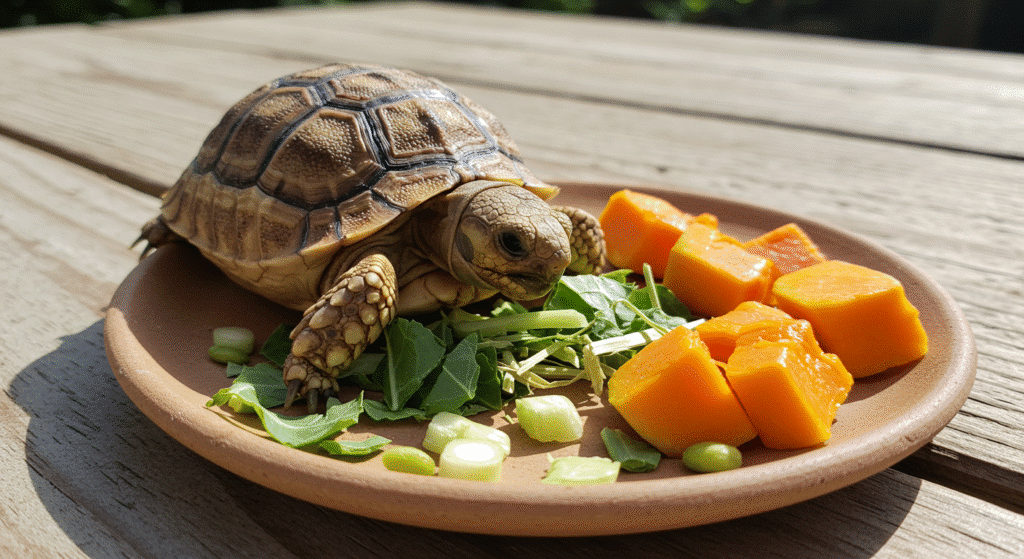
Feeding Frequency for Steady Development: Feed baby sulcatas daily during their first 12 months, transitioning to every other day as they approach 18-24 months. Consistent feeding schedules support steady growth without the rapid spurts that can cause shell problems.
Portion Control That Promotes Health: Offer amounts equal to 1.5 times the area of your tortoise’s shell. This provides adequate nutrition for healthy growth without the overfeeding that leads to rapid weight gain and developmental problems.
Strategic Supplementation: Use our Baby Sulcata Superfood Powder to ensure your growing tortoise receives optimal nutrition ratios specifically formulated for healthy development. This eliminates the guesswork in balancing multiple nutrients during critical growth periods.
Calcium and Mineral Balance: Dust food with calcium (without D3) 5-6 times per week and calcium with D3 1-2 times per week. The exact ratio depends on UVB exposure and individual needs.
Our Vitamin and Mineral Topper provides comprehensive mineral support beyond just calcium, including the trace minerals essential for healthy shell and bone development that are often missing from basic supplements.
Exercise and Activity for Healthy Development
Space Requirements for Natural Movement: Baby sulcatas need much more space than most keepers provide. Minimum enclosure size should be 4×8 feet for tortoises under 6 months, expanding as they grow. Cramped conditions contribute to poor muscle development and abnormal shell formation.
Terrain Variety for Natural Behaviors: Create varied terrain with gentle slopes, rocks to climb over, and obstacles that encourage natural movement patterns. This physical activity promotes healthy bone development and prevents the muscle weakness associated with sedentary lifestyles.
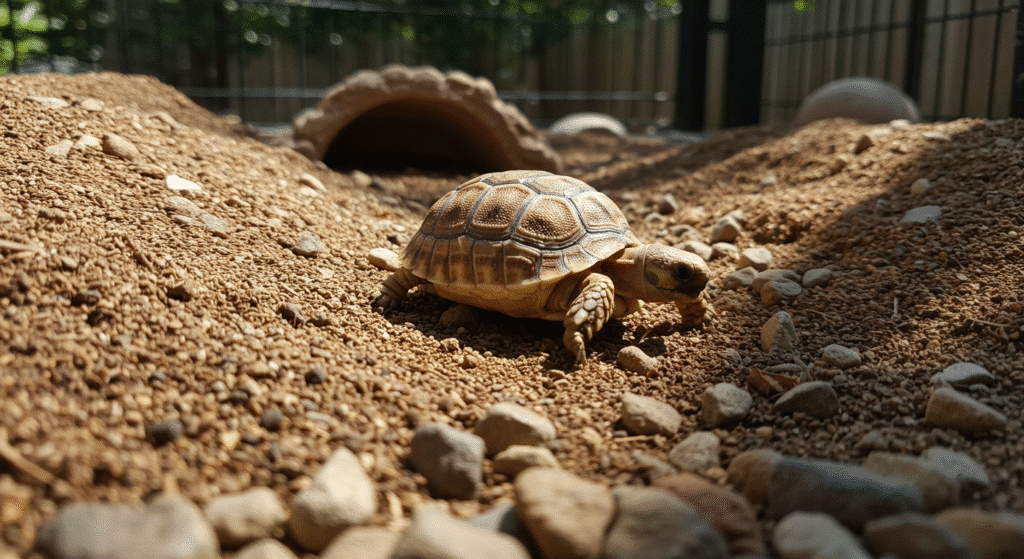
Outdoor Access Benefits: When weather permits, provide supervised outdoor access on natural ground. Walking on varied surfaces, navigating natural obstacles, and experiencing natural temperature and humidity variations all contribute to optimal development.
Exercise Timing and Duration: Encourage activity during the warmest parts of the day when your tortoise is most active. Young sulcatas should be moving around for several hours daily, not just basking or hiding.
Stress Management for Optimal Growth
Minimizing Handling Stress: Limit handling to necessary health checks and enclosure maintenance. Excessive handling, especially during critical growth periods, can cause stress that impacts development and immune function.
Environmental Consistency: Maintain consistent daily routines for feeding, lighting, and temperature cycles. Baby sulcatas thrive on predictability, and routine changes can cause stress that affects growth rates.
Hiding and Security Needs: Provide multiple hiding spots of different types: humid hides for shell health, dry hides for thermoregulation, and secure areas where your tortoise can retreat when feeling stressed.
Social Considerations: If keeping multiple baby sulcatas together, monitor for competition and aggression. Stressed tortoises from social conflicts often show poor growth rates and increased susceptibility to illness.
Monitoring and Adjusting Growth Support
Weekly Growth Tracking: Weigh your baby sulcata weekly using a digital scale accurate to 1 gram. Record weights alongside notes about appetite, activity level, and any environmental changes.
Monthly Development Assessment: Measure shell length and width monthly, photograph from consistent angles, and assess overall body condition. This comprehensive monitoring helps identify subtle problems before they become serious.
Environmental Monitoring: Use digital thermometers and hygrometers to continuously monitor temperature and humidity levels. Place monitoring devices at tortoise level for accurate readings.
Behavioral Observations: Track daily behaviors: feeding response, activity levels, basking duration, and interaction with the environment. Changes in normal behavior patterns often signal developing problems.
Are You Starving Your Tortoise?
Save 10% on premium tortoise food and supplements from Tortoise Resource Center on Amazon now using code BUYNOWGET10
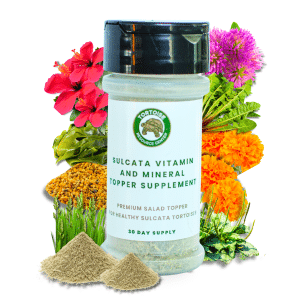
Sulcata Vitamin & Mineral Topper Supplement
30-Day Supply | 2 oz (56 g)
$24.99
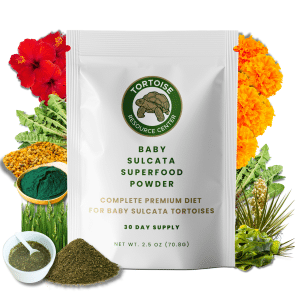
Baby Sulcata Tortoise Superfood Powder
30-Day Supply | 2.5 oz (70.8 g) Bag
$24.99
Age-Specific Growth Support Strategies
Hatchling Phase (0-6 months): Focus on establishing optimal conditions and close monitoring. This is the most critical period for setting up lifelong health patterns.
- Daily feeding with premium nutrition
- Consistent environmental conditions
- Minimal stress and handling
- Weekly weight monitoring
- Immediate response to any concerning changes
Young Juvenile Phase (6-12 months): Maintain intensive support while beginning to establish patterns that will carry into the next growth phase.
- Continue daily feeding with gradual variety increases
- Expand enclosure size as the tortoise grows
- Begin transitioning to slightly less intensive monitoring
- Start planning for eventual adult-sized housing
Older Juvenile Phase (12-18 months): Begin transitioning toward less intensive management while maintaining optimal conditions.
- Transition to every-other-day feeding if growth rates support it
- Reduce monitoring frequency while maintaining consistency
- Begin considering adult housing and care requirements
Seasonal Adjustments for Growth Support
Spring Growth Optimization: Take advantage of natural growth acceleration during spring months by ensuring optimal nutrition and environmental conditions. This is often when the most dramatic healthy growth occurs.
Summer Maintenance: Maintain consistent conditions during peak growing season while watching for signs of too-rapid growth that might require feeding adjustments.
Fall Preparation: Begin preparing for seasonal growth slowdowns by adjusting expectations and fine-tuning environmental conditions for potential temperature changes.
Winter Adaptation: Maintain consistent indoor conditions even as outdoor temperatures fluctuate. Some growth slowdown is normal, but environmental consistency prevents problematic variations.
Common Growth Support Mistakes
Mistake #1: Focusing Only on Feeding: Many keepers think growth support is just about nutrition, ignoring crucial environmental factors like humidity, exercise, and stress management.
Mistake #2: Maximizing Growth Speed: Trying to achieve maximum growth rates often leads to rapid development that causes shell deformities and long-term health problems.
Mistake #3: Inconsistent Conditions: Sporadic good conditions don’t support optimal growth—consistency is more important than perfection.
Mistake #4: Adult Care Too Early: Applying adult care requirements to baby tortoises prevents optimal development during critical growth periods.
Mistake #5: Inadequate Monitoring: Without regular monitoring, problems can develop and progress significantly before becoming obvious.
Supporting Growth During Health Challenges
Illness Recovery Support: If your baby sulcata becomes ill, maintain optimal environmental conditions while working with a veterinarian. Recovery often requires enhanced nutritional support and stress reduction.
Post-Treatment Growth Resumption: After treating health problems, expect a period of catch-up growth as your tortoise recovers. Monitor closely to ensure this recovery growth remains healthy.
Preventing Growth Setbacks: Proactive health monitoring and immediate response to problems prevents the growth setbacks that can occur when issues are allowed to progress.
Long-term Growth Support Planning
Preparing for Size Increases: Plan for rapid size increases by having larger housing ready before it’s needed. Growth spurts can happen quickly, and cramped conditions immediately impact development.
Equipment Scaling: As your tortoise grows, heating, lighting, and water requirements change. Plan equipment upgrades to maintain optimal conditions as your tortoise develops.
Adult Transition Preparation: Begin planning adult housing and care requirements early. The transition from juvenile to adult care should be gradual and well-planned.
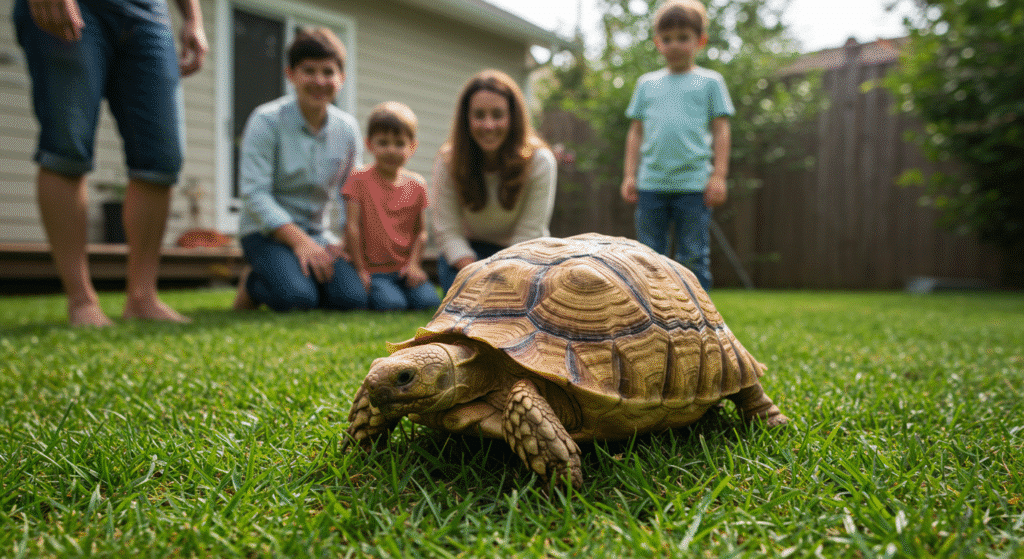
Creating Your Growth Support System
Daily Routine Development: Establish sustainable daily routines that support consistent growth conditions. The best growth support plan is one you can maintain long-term.
Emergency Preparedness: Have backup systems for heating, lighting, and nutrition in case of equipment failures or supply disruptions during critical growth periods.
Professional Support Network: Establish relationships with reptile veterinarians and experienced keepers before problems arise. Professional guidance during growth phases can prevent serious issues.
Record Keeping Systems: Develop record-keeping systems that track growth, environmental conditions, feeding, and behavioral observations. This data becomes invaluable for optimizing care and identifying problems early.
The Investment in Optimal Growth
Supporting optimal baby sulcata growth requires significant time, attention, and resources during the first 18 months of life. However, this investment pays enormous dividends in the form of:
- Healthy shell development without deformities
- Strong bone structure that lasts for life
- Robust organ development and function
- Excellent immune system function
- Reduced veterinary costs throughout life
- A tortoise capable of living 50+ healthy years
The growth support you provide now literally shapes your tortoise’s entire future. Baby sulcatas that receive optimal growth support during these critical months develop into strong, healthy adults with excellent quality of life and longevity.
Your baby sulcata is counting on you to provide the foundation for healthy development. With comprehensive growth support that addresses environmental conditions, nutrition, exercise, stress management, and consistent monitoring, you can ensure your tortoise develops into the magnificent, healthy adult it’s meant to become.
The time and effort you invest in supporting optimal growth during these crucial early months will benefit your tortoise—and you—for decades to come. This is your opportunity to give your sulcata the best possible start in life, and the results will be evident in every healthy year that follows. Want to learn more? Download our free sulcata care bonus pack today!
